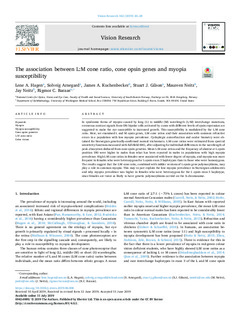| dc.contributor.author | Hagen, Lene Aarvelta | |
| dc.contributor.author | Arnegard, Solveig | |
| dc.contributor.author | Kuchenbecker, James A | |
| dc.contributor.author | Gilson, Stuart | |
| dc.contributor.author | Neitz, Maureen | |
| dc.contributor.author | Neitz, Jay | |
| dc.contributor.author | Baraas, Rigmor C. | |
| dc.date.accessioned | 2019-10-22T08:20:28Z | |
| dc.date.available | 2019-10-22T08:20:28Z | |
| dc.date.created | 2019-09-10T16:36:52Z | |
| dc.date.issued | 2019 | |
| dc.identifier.citation | Vision Research. 2019, 162, 20-28. | nb_NO |
| dc.identifier.issn | 0042-6989 | |
| dc.identifier.uri | http://hdl.handle.net/11250/2623633 | |
| dc.description | Published by Elsevier Ltd. This is an open access article under the CC BY license. | nb_NO |
| dc.description.abstract | Elsevier Vision Research Volume 162, September 2019, Pages 20-28 Vision Research The association between L:M cone ratio, cone opsin genes and myopia susceptibility Author links open overlay panelLene A.HagenaSolveigArnegardaJames A.KuchenbeckerbStuart J.GilsonaMaureenNeitzbJayNeitzbRigmor C.Baraasa Show more https://doi.org/10.1016/j.visres.2019.06.006Get rights and content Under a Creative Commons licenseopen access Highlights • Low myopia prevalence in Norwegian adolescents. • High mean L:M cone ratio in both Norwegian males and females. • High L:M cone ratios in females were associated with lower degree of myopia. • Myopia was more frequent in females heterozygous for L opsin exon 3 haplotypes. • Milder versions of L exon 3 skipping variants may play a role in common myopia. Abstract In syndromic forms of myopia caused by long (L) to middle (M) wavelength (L/M) interchange mutations, erroneous contrast signals from ON-bipolar cells activated by cones with different levels of opsin expression are suggested to make the eye susceptible to increased growth. This susceptibility is modulated by the L:M cone ratio. Here, we examined L and M opsin genes, L:M cone ratios and their association with common refractive errors in a population with low myopia prevalence. Cycloplegic autorefraction and ocular biometry were obtained for Norwegian genetically-confirmed normal trichromats. L:M cone ratios were estimated from spectral sensitivity functions measured with full-field ERG, after adjusting for individual differences in the wavelength of peak absorption deduced from cone opsin genetics. Mean L:M cone ratios and the frequency of alanine at L opsin position 180 were higher in males than what has been reported in males in populations with high myopia prevalence. High L:M cone ratios in females were associated with lower degree of myopia, and myopia was more frequent in females who were heterozygous for L opsin exon 3 haplotypes than in those who were homozygous. The results suggest that the L:M cone ratio, combined with milder versions of L opsin gene polymorphisms, may play a role in common myopia. This may in part explain the low myopia prevalence in Norwegian adolescents and why myopia prevalence was higher in females who were heterozygous for the L opsin exon 3 haplotype, since females are twice as likely to have genetic polymorphisms carried on the X-chromosome. | nb_NO |
| dc.language.iso | eng | nb_NO |
| dc.rights | Navngivelse 4.0 Internasjonal | * |
| dc.rights.uri | http://creativecommons.org/licenses/by/4.0/deed.no | * |
| dc.title | The association between L:M cone ratio, cone opsin genes and myopia susceptibility | nb_NO |
| dc.type | Journal article | nb_NO |
| dc.type | Peer reviewed | nb_NO |
| dc.description.version | publishedVersion | nb_NO |
| dc.rights.holder | © 2019 The Authors | nb_NO |
| dc.source.pagenumber | 20-28 | nb_NO |
| dc.source.volume | 162 | nb_NO |
| dc.source.journal | Vision Research | nb_NO |
| dc.identifier.doi | 10.1016/j.visres.2019.06.006 | |
| dc.identifier.cristin | 1723424 | |
| cristin.unitcode | 222,56,2,0 | |
| cristin.unitname | Institutt for optometri, radiografi og lysdesign | |
| cristin.ispublished | true | |
| cristin.fulltext | original | |
| cristin.qualitycode | 1 | |

